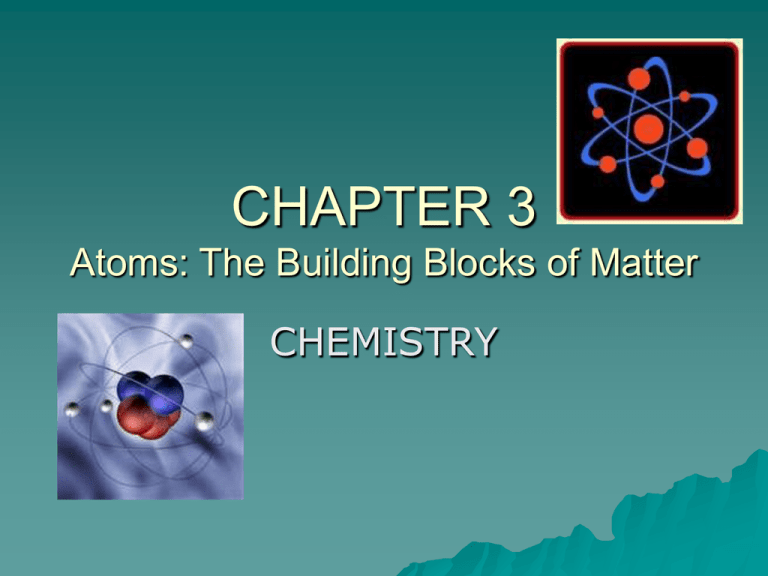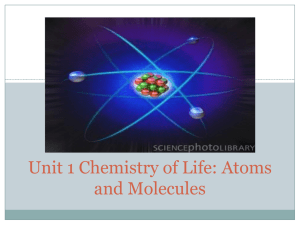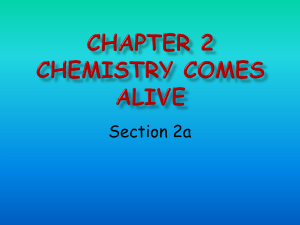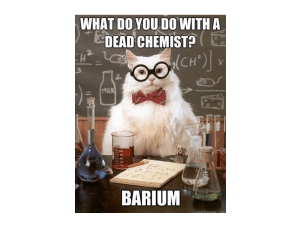CHAPTER 3 Atoms: The Building Blocks of Matter
advertisement

CHAPTER 3 Atoms: The Building Blocks of Matter CHEMISTRY Foundations of Atomic Theory History – Greek Democritus – “atom” – could not be divided anymore Aristotle and Plato - argued – 1600-1700s Natural Philosophers – Experimentation – balances – quantitative measurements Atom – Comes from Greek “a” – not “tomos” – cutting indivisible Foundations of Atomic Theory Chemical Reaction – Transformation of substances into one or more new substances – Chemical change Law of Conservation of Mass – Mass is neither created nor destroyed in ordinary chemical reactions – http://www.youtube.com/watch?v=dExpJAECS L8 Law of Definite Proportions – A chemical compound contains the same elements in exactly the same proportions by mass regardless of size of sample – Ex – H2O, CO2 Foundations of Atomic Theory Law of Multiple Proportions – If two or more compounds are composed of the same 2 elements, the masses can be expressed as ratios of small whole numbers Dalton’s Atomic Theory John Dalton English School Teacher 1803 Dalton’s Atomic Theory 5 Points in his theory – All matter is composed of extremely small particles called atoms – Atoms of a given element are identical in size, mass, and other properties – Atoms cannot be subdivided, created, or destroyed – Atoms of different elements combine in simple whole number ratios to form compounds – In chemical reactions, atoms are combined, separated, or rearranged Dalton’s Atomic Theory Modern Atomic Theory There have been some changes since Dalton’s Theory Important concepts of modern theory – Atoms of one element can differ from each other - ISOTOPES – An atom is made of smaller parts Structure of the Atom Atom – smallest particle of an element that can exist alone – Two regions of an atom Nucleus – Center of atom – Protons and neutrons Electron “cloud” – Area surrounding nucleus containing electrons Discovery of the electron Symbol e Cathode ray tubes (CRT) – Vacuum tube containing an electron gun (a source of electrons) and a fluorescent screen, with internal or external means to accelerate and deflect the electron beam, used to form images in the form of light emitted from the fluorescent screen. – Used in TV, computer monitors Discovery of the electron Charge and mass of the electron – JJ Thomson – 1897 Discovered the electron 1907 Nobel Prize in Physics http://videos.howstuffworks.com/hsw/6298-atomicstructure-electrons-video.htm Did experiments with CRT – – Found that the charge to mass ration was always the same Discovery of the atomic nucleus Ernest Rutherford – 1908 Gold Foil Experiment Composition of the nucleus Protons – Positive charge http://videos.howstuffworks.com/hsw/5 806-atomic-structure-the-nucleusvideo.htm Neutrons – Neutral charge http://videos.howstuffworks.com/hsw/58 07-atomic-structure-neutrons-video.htm Forces in Nucleus Nuclear forces – Forces that hold nuclear particles together – Binds protons and neutrons into the atomic nucleus Sizes of Atoms Based on distance electrons travel away from the nucleus http://videos.howstuffworks.com/hsw/578 8-size-of-atoms-matter-video.htm Summary Counting Atoms Atomic Number – Symbol Z – Number of protons in nucleus – The number of protons determines identity of the element!! Counting Atoms Isotopes – Atoms of the same element with varying number of neutrons – Nuclide – general term for any isotope of any element – Mass Number – total number of protons + neutrons Counting Atoms The isotope of hydrogen – Protium – one proton only; 1e– Deuterium – one proton, one neutron, one electron – Tritium – one proton, two neutrons, one electron; radioactive – http://www.citycollegiate.com/isotopeso fhydrogen.htm Counting Atoms Designating Isotopes – Hyphen notation Name-mass # Uranium-235 – How many p, n, e-? Ex – Neon with 12 neutrons? – Nuclear Symbol Notation MN AN Element 3 H 1 235 U 92 symbol How many p,n,e- in chlorine-37? Relative Atomic Mass Relative scale – Standard needed to be set – Carbon-12 All others compared to Carbon-12 Atomic mass unit – amu – The mass of an individual atom – Honors: Approximate mass of a proton or a neutron Average Atomic Mass Weighted average of the atomic masses for all known isotopes – Calculating average atomic mass: Relating mass to the number of atoms “Particle” – a generic term Mole – SI unit for amount of substance, counting unit – Symbol – mol – Avogadro’s number 6.02 x 1023 – number of particles in 1mol of substance – Molar mass Mass of 1mol of substance – on P.T. Conversions Gram Mole Mole Particle Gram Particle Mole Gram Particle Mole Particle Gram Facts (Conversion Factors): #g PT = 1 mol 6.02 x 1023 particles = 1 mol Conversions Gram Mole; Mole Gram Conversions Mole Particle; Particle Mole Conversions Gram Particle; Particle Gram










